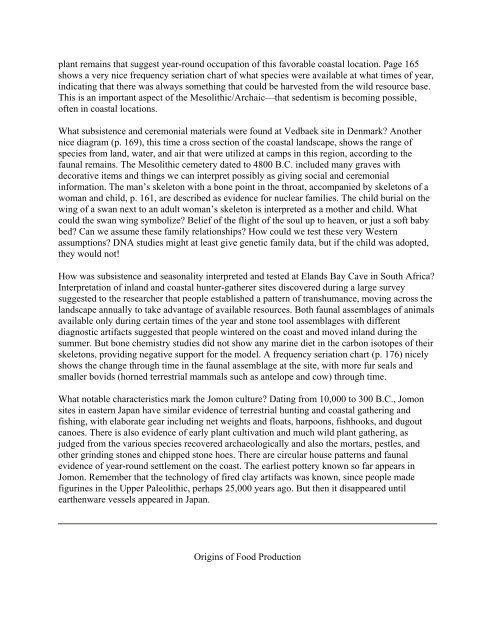INTRODUCTION TO ARCHAEOLOGY Nancy White - Touro Institute
INTRODUCTION TO ARCHAEOLOGY Nancy White - Touro Institute
INTRODUCTION TO ARCHAEOLOGY Nancy White - Touro Institute
Create successful ePaper yourself
Turn your PDF publications into a flip-book with our unique Google optimized e-Paper software.
plant remains that suggest year-round occupation of this favorable coastal location. Page 165<br />
shows a very nice frequency seriation chart of what species were available at what times of year,<br />
indicating that there was always something that could be harvested from the wild resource base.<br />
This is an important aspect of the Mesolithic/Archaic—that sedentism is becoming possible,<br />
often in coastal locations.<br />
What subsistence and ceremonial materials were found at Vedbaek site in Denmark? Another<br />
nice diagram (p. 169), this time a cross section of the coastal landscape, shows the range of<br />
species from land, water, and air that were utilized at camps in this region, according to the<br />
faunal remains. The Mesolithic cemetery dated to 4800 B.C. included many graves with<br />
decorative items and things we can interpret possibly as giving social and ceremonial<br />
information. The man’s skeleton with a bone point in the throat, accompanied by skeletons of a<br />
woman and child, p. 161, are described as evidence for nuclear families. The child burial on the<br />
wing of a swan next to an adult woman’s skeleton is interpreted as a mother and child. What<br />
could the swan wing symbolize? Belief of the flight of the soul up to heaven, or just a soft baby<br />
bed? Can we assume these family relationships? How could we test these very Western<br />
assumptions? DNA studies might at least give genetic family data, but if the child was adopted,<br />
they would not!<br />
How was subsistence and seasonality interpreted and tested at Elands Bay Cave in South Africa?<br />
Interpretation of inland and coastal hunter-gatherer sites discovered during a large survey<br />
suggested to the researcher that people established a pattern of transhumance, moving across the<br />
landscape annually to take advantage of available resources. Both faunal assemblages of animals<br />
available only during certain times of the year and stone tool assemblages with different<br />
diagnostic artifacts suggested that people wintered on the coast and moved inland during the<br />
summer. But bone chemistry studies did not show any marine diet in the carbon isotopes of their<br />
skeletons, providing negative support for the model. A frequency seriation chart (p. 176) nicely<br />
shows the change through time in the faunal assemblage at the site, with more fur seals and<br />
smaller bovids (horned terrestrial mammals such as antelope and cow) through time.<br />
What notable characteristics mark the Jomon culture? Dating from 10,000 to 300 B.C., Jomon<br />
sites in eastern Japan have similar evidence of terrestrial hunting and coastal gathering and<br />
fishing, with elaborate gear including net weights and floats, harpoons, fishhooks, and dugout<br />
canoes. There is also evidence of early plant cultivation and much wild plant gathering, as<br />
judged from the various species recovered archaeologically and also the mortars, pestles, and<br />
other grinding stones and chipped stone hoes. There are circular house patterns and faunal<br />
evidence of year-round settlement on the coast. The earliest pottery known so far appears in<br />
Jomon. Remember that the technology of fired clay artifacts was known, since people made<br />
figurines in the Upper Paleolithic, perhaps 25,000 years ago. But then it disappeared until<br />
earthenware vessels appeared in Japan.<br />
Origins of Food Production
















